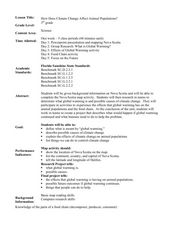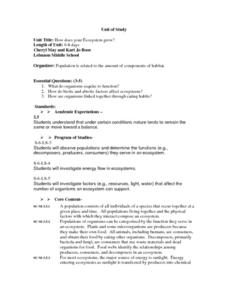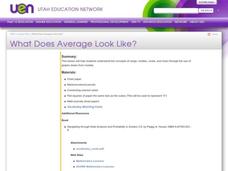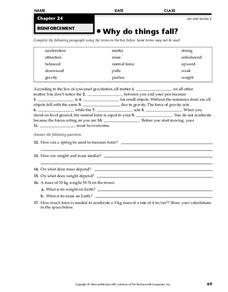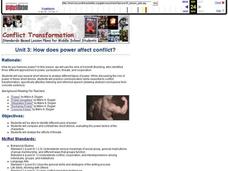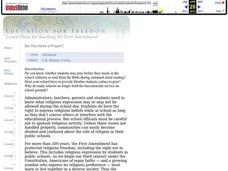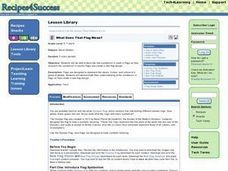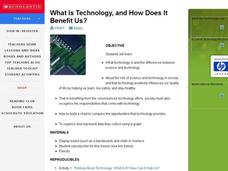Curated OER
How Does a Butterfly Grow?
Students explore the stages of a butterfly. They read and discuss the book, The Very Hungry Caterpillar, by Eric Carle. They draw a picture of their favorite part and create a graph. They write a letter to Eric Carle and observe a...
Curated OER
What Does Ginny Have?
In this grammar worksheet, students read a short paragraph and then fill in 14 blanks within the paragraph with the correct form of the verbs have or has.
Curated OER
How Does Climate Change Affect Animal Populations?
Learners investigate the effect of climate change on animal population in Nova Scotia. In this environmental science lesson, students complete a Nova Scotia map activity and research the causes of global warming in small groups. Learners...
Curated OER
What Does the Inside of a Seed Look Like?
First graders study seeds. In this biology lesson, 1st graders observe the differences between dry and wet seeds and draw what is inside a seed after peeling off the outer coat of one of the seeds.
Curated OER
Changing States: Does it Matter
Young scholars participate in experiments to visualize the differences between chemical and physical changes. They attempt to detect the five characteristics of a chemical change.
Curated OER
How Much Does That Car Cost?
Students calculate how much it costs to buy a used car and finance it through a bank. They select a car from the newspaper, conduct Internet research on current auto loan interest information for four different states, and create a...
Curated OER
"Here's much to do with hate, but more with love": The Prologue in Romeo and Juliet
Young scholars participate in a guide close reading of the Prologue to Romeo and Juliet. They write a prologue sonnet to another piece of literature they have read.
Curated OER
How Does Your Ecosystem Grow?
Students consider that under certain conditions in nature tend to remain the same or move toward a balance. They observe populations and determine the functions (e.g., de-composers, producers, consumers) they serve in an ecosystem. They...
Curated OER
What Does Average Look Like?
Fifth graders explore the concepts of range, median, mode, and mean through the use of graphs drawn from models. They use manipulatives to represent data they have collected within their groups, and compare the differences between mode,...
Curated OER
Why Do Things Fall?
In this universal gravitation activity, students fill in the blanks to complete sentences with 11 given terms about gravity, inertia, acceleration, mass and force. Students also answer 7 questions about mass, weight and force.
Curated OER
How Does Power Affect Conflict?
Students use several short stories to analyze different types of power. While discussing the role of power in these short stories, students will practice communication skills essential to conflict transformation, specifically attentive...
Curated OER
Doing a Lab Write Up
In this science worksheet, students examine the topic in order to solidify knowledge covered in the curriculum using puzzles and creative games.
Curated OER
What Do They Do?
In this conversation worksheet, students ask a partner 12 questions about people's professions. Students fill in the missing information by listening to their partner's response.
Curated OER
What Does The Heart Do?
Students study the relationship between the heart and circulation. In this circulatory system lesson plan, students read the "What Am I?" article about the heart and discuss. Students draw a heart and lungs, discover how blood is...
Curated OER
What Do I Wear in the Winter?
Students identify the appropriate clothing to wear in the winter. In this seasonal weather lesson, students discuss what warm and cold weather feels like and what clothing is necessary during the specific seasons. Students explore...
Curated OER
I'm Proud... My Husband Wants Me To Do My Part
In this World War II instructional activity, learners examine a propaganda poster featuring women and the war effort and then respond to 4 short answer questions based on their analysis of the poster.
Curated OER
Do You Have a Prayer?
Students review the 1st Amendment and the clauses which deal with prayer/religion in schools. They discuss, in groups, the Equal Access Act, which gives students the right to practice/express their religion at school and take a quiz on...
Curated OER
What Does That Flag Mean?
Students describe how symbolism is used in flags as they research the symbolism in country flags and create a new flag design. They begin investigating the meaning behind the Olympic flag and then continue with the flags of South Africa...
Curated OER
What Is Technology, and How Does It Benefit Us?
Young scholars examine and define what technology is as well as the differences between science and technology. They assess the role of science and technology in society, conveniences technology offers and create a chart to compare the...
National First Ladies' Library
Why Do We Have Libraries?
Students investigate the reason and origins of libraries and conduct an information search using a variety of resources. They are divided into groups that have a specific set of questions they are to answer. Each group will then complete...
Curated OER
What Does It Need?
In this identifying needs worksheet, students observe picture words and fill in the correct boxes indicating their needs of water, air, and food. Students determine the needs for seven items.
Curated OER
How Does the Angle Effect How Fast a Car Will Travel?
In this angle of movement and speed worksheet, learners determine at which angle a car will travel the fastest. They test 12 different angles on a toy car and determine from their data which angle is the best for speed.
Curated OER
Where Does Food Go?
Students understand how their food moves through the digestive system. In this digestion lesson, students measure the length of the digestive system from a projection of it. Students draw their own pictures of the digestive system.
Facing History and Ourselves
Continuing Lemkin's Legacy: What Can We Do to Prevent and Stop Genocide?
Young scholars investigate genocide. For this contemporary history lesson, high schoolers research Darfur advocacy organizations and present plans of action to stop the injustice in Darfur.
Other popular searches
- Do Does and Did
- Does and Do
- Grammar Do and Does
- Using Do or Does
- Verbs Do and Does
- Esl Do Does
- Do Does Grammar
- Do Does Questions
- Does or Do
- Do Does Practice
- Esl Do Does Game
- Do, Does,did




